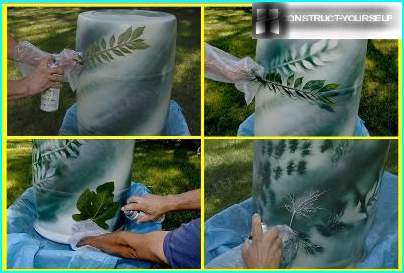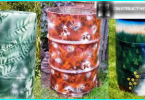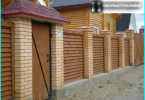
Any cottager acquires land primarily for recreation from the busy city life. But gradually the land becomes an additional source of fresh vitamins, because it is illogical to go to the village, having purchased a trunk of the vegetables and herbs. All this can be to grow right at hand. The only «but» — small piece. You have to sacrifice or beds, or flowerbeds, and young gardeners usually prefer a beautiful landscape. Actually, any vegetable can fit in the style area, if you show imagination. For example, conventional potatoes were once considered a decorative culture, and cultivated solely for the sake of delicate flowers. So in the garden you can find a place for him and the cucumbers, and even pumpkins. Consider how to create mouth-watering flowerbed, to combine culture and save at the same time on the territory.
The contents
The best vegetable crops for the flower garden
Have landscape designers has a range of decorative plants. Some crops can be planted in any type of beds and they will look spectacular all season. Others are designed only for a certain type of flower garden and ornamental short time.
Let’s consider the most beautiful among the plants commonly used for food, but great for your new vegetable beds.
Ornamental Kale
Despite the name, the culture is quite edible and enjoyed a special respect from the French. The bright colors and the corrugated form of the sheet rivals the beauty of many colors.
Cabbage is used as a border, the main crop of the lower tier and in potting compositions. Plus ornamental cabbage is that it to late autumn retains spectacular view, even when it is in arrow.
Ornamental Kale likes to grow near the marigolds, to repel from her butterflies and secrete substances, disinfecting the soil
In the long perennial borders look good varieties of red, Savoy and cauliflower.
Bluish with violet tint the color of the cabbage stands in stark contrast to the flowering plants, but this vegetable requires a lot of space
Ornamental varieties of onions
Again, the word «decorative» does not mean «inedible». Three of the most beautiful varieties – chives, aflatuni and slizun have excellent taste. And chives ramping up the pen in early spring, when the regular bulbs are just beginning to sprout.
When you create flower beds with onions note that this plant cannot be planted on the front row, as there will come a time when the leaves turn yellow and wither, which means that the bed thins out.
The bow just feels better «behind» plants that will bloom in the summer or fall and cover with leaves deserted land. Put onions in a continuous belt or alternate with semi-circular bushes. Looks great pen bow in the Alpine hill.
1 — chives, 2 — aflatuni bow, 3 — bow slizun. Each of them has its good in the garden
Aflatuni onion is valued for its juiciness and hint of garlic. Its fleshy leaves is beautiful only in spring, but after the time comes for popping chic flower on a high stem and the pen at this time is on the wane. So aflatuni onions are planted either in the background of a flower bed to create a dense green backdrop of spring, or in the center of the bed. In the summer the empty space will cover the grown culture from the edge.
Longer than the others retain green leaves bow-slizun, as it blooms in July. Therefore, spots of greenery in the garden you can shape it out of him.
Artichoke and rhubarb
These vegetable crops can act as landscape plants tapeworms. Powerful notched foliage and beautiful shape of the Bush point of view from afar. They are easy to combine with flowers, the stem needs support: gladiolus, large-flowered irises, daylilies, as the powerful stems in windy weather will hold and «neighbor».
1 – artichoke, 2 – rhubarb. Powerful plant leaves are scattered on an area of more than meters, and a highly developed root system helps to successfully grow in the shade
Artichoke vymachivanie up to 2 meters and is used as a Central plant in the tiered flower bed. If you don’t eat it bumps, then they eventually blossom charm beads with purple halo at the end. The shape of the usual Thistle.
The leaves of rhubarb and artichoke are used in fresh salads, as they are rich in medicinal properties. So all the Housewives who dream of a slim figure, it should be planted on the site of these giants.
Green salads
Perhaps the most beautiful form of leaves possess salads. Their luscious greenery can decorate not only the dining table but in the Central beds. Particularly spectacular salad curbs and edging borders.
Lettuce culture are rapidly increasing the green mass and look impressive until mid-summer until the release flower arrow
Lettuce, frisse, spinach, chard, and iceberg BLOB forms a dense foliage, which looks nice in rock gardens, in containers and wide pots. To plant salads are along the blind area of the building, as they are not afraid shady places and love the moisture.
Radicchio, Lollo Rosso, red oakleaf and is introduced into the flower garden for bright purple or reddish-brown hue. They add colour to the lower tier of beds. By the way, the ordinary table beet has the same rich color of the foliage, so the beds can be planted 3-4 next.
Tea greens and herbs
This group of plants in the plot design is used quite often nowadays. Spicy tea and flower beds now in the trend. Of spices for the Central flower beds are suitable:
- parsley (especially curly varieties);
- Basil (valued for purple foliage);
- marjoram (stands out in the flower beds Golden color);
- rosemary (draws needle shape leaves and beautiful blue flowers);
- hyssop (an extraordinarily beautiful purple or blue panicles during flowering);
- sage (high growth and large blue blossoms).
Examples:
1 – sage 2 – hyssop, 3 – rosemary 4 – Basil. Each herb can be used in the garden as a plant of the upper tier
And of these herbs can be done «the monastery garden»:
Among cultures that add to homemade teas in the flower beds often will see:
- Melissa and mint (carved foliage reminiscent of nettles, high Bush, but holds its shape well);
- thyme, a second name – creeping thyme (a great groundcover plant that will make as much land as he will take, successfully combined in the flower beds with alyssum);
- monardo (Tall flower that looks good in the center of the bed, on the edge of the lawn, paths. For menardou easy to hide ugly old fence. Can be combined with the host, astilbe, cereals);
- Echinacea (has showy bright flowers, resembling a large Daisy. The color palette is huge, forming a tall Bush with solid stems, not afraid of wind).
1 – thyme, 2 – mint. From thyme to create «carpets» in the Alpine coaster, and mint to plant dominant in the bed center
Green leaves of monarda prepare teas to help with colds, as well as to add flavor to salads and fish dishes
Fashion forms «edible» flower beds
As the fashion for garden flower beds swept the whole world, landscape designers began to look for unusual shapes of flower beds where comfortable and vegetable, and ornamental crops. Consider the most interesting solutions.
Option #1 — chess game from Marjorie Harris
An experienced gardener from Toronto, Ontario, Canada Marjorie Harris invented a form of chess Board, in which the green cells interspersed with white. Create green plants, and white squares are closed with concrete tile.
As a rule, in the form of chess create the tracks, sowing the squares of grass, but Marjorie Harris uses this form to delicious flower beds
What are the benefits:
- Tile accumulating the day heat and gradually releases it to the soil in the night, thereby maintaining a constant temperature in the root system of plants.
- To care for plants just because standing on the tile will not smear the legs.
- Half reduced the size of the weeding, and therefore, not overworked, and weeds in a flowerbed almost never happens.
- The light color of the tiles reflects the sun’s rays, and they are better illuminate the entire surface of the plant, and hence the growth of the crops will be better.
- You can use the shaded space, because the reflecting rays enough for the normal development of crops.
In chess the most successful flower beds growing greens and beets.
Option #2 — the strict geometry of Andrea du serso
Name this French architect of the contemporary, as he did in the SIXTEENTH century. But his idea of geometric flower beds-garden beds today is experiencing a rebirth.
The idea of Andrea to break the square footage allocated for the flower beds, into equal squares, each of which limit a border of boxwood or other shrubs. The same square beds would streamline the space, make it symmetrical.
The boxwood border for flower beds to grow over the years, so you can replace them kochii or marigolds, which are easily cut to the desired shape
But inside each flower bed will be your figure. On the same plants can be planted in a circle, on the other – ranks third in sun shape and so on one Condition: a maximum of 3 cultures on each square, and with different colored foliage and inflorescences.
It is the play of colors + strict geometry and create that bold look that impresses tourists in the garden of the old castle of Villandry. But if you are on a parcel shall the like – all the neighbors and guests will be in culture shock.
Option #3 — tiered spicy garden from Nan Sterman
Designer from California Nan Sterman called his idea «tiered garden lazy spice». The essence of the flower beds is to put together fruit and herbs, resistant to drought and to plant them in tiers, like the gardens of Babylon. Each layer maintains its own step, so it was convenient to collect culture for Breakfast.
In the organization «lazy» beds it is important to place the irrigation system and to combine plants with similar requirements to the soil
Lazy garden, national Academy of Sciences called because there is automatic irrigation, drip irrigation method, and the whole soil is covered with a thick layer of mulch. Therefore, the owner can do is to admire the flowerbed, but to collect her harvest. No extra work.
In such flower beds Nan Sterman also uses container fit to raise a certain level above the ground.
Option #4 — garden Crescent from Deborah of Printing
Another florist came up with to organize garden flower beds shaped like a Crescent. Exit to the courtyard of the house begins with a semi-circular patio, the surface of which is closed by a tile or other decorative material.
From patio diverge the beam, each of which is part of the design. In the extreme sectors are created flowerbeds of herbs and vegetable crops mixed with flowers, in the Central – dwarf fruit garden + berry. This breakdown makes the whole territory, as all the rays «flocking» the lounge.
The highest aesthetic effect of a garden-Crescent are the owners, standing on the balcony of the upper floor of the house, where from you can see the whole territory
Deborah PRINZING promotes the idea: everything on the site is suitable for a bouquet. Went into the garden and cut a sprig of pea, a bundle of Basil, chamomile flower… All cultures have the right to decorate the house and stand in beautiful vases.
Option #5 — vertical beds from Amy Stuart
Famous American biologist Amy Stewart has created a book «The drunken botanist», where offered readers an alternative to alcoholic drinks, floral cocktails. Method of research it has proved that the homemade drinks however, it is not worse than the hyped pop and soft mixture. In addition, each flower when you add it to alcohol making its aroma and taste, and the drink is akin to a dear perfume for the elite.
For the research she wanted a huge flower garden with spicy and aromatic herbs, and the plot was not. I had to use the fence and a narrow strip of land along it. All crops were planted in containers at different levels. In this way the garden turned vertical.
If you separated from the neighbors high fence – make it directly into a garden of spices, adding for paints curly strawberries and petunias.
Flowerbed Amy Stewart differs from vertical beds of the fact that there is combined blooming and spicy culture, and for beauty added mirror
In creating «edible» flower beds should take into account a caveat: not all plants are compatible with each other. Before you combine beets and hydrangea, parsley, and rose – compare the conditions of their cultivation. Because of the level of acidity and moisture, which likes one culture, may be disastrous for another.






